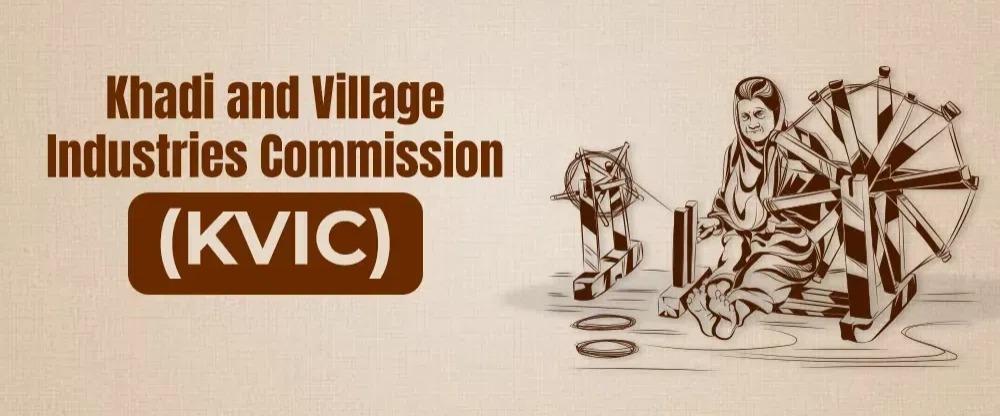Table of Contents
The Khadi and Village Industries Commission (KVIC) is a prominent organization established under the Indian Constitution, operating within the purview of the Ministry of Micro, Small, and Medium Enterprises. The Khadi and Village Industries Act of 1956, which was later revised in 1965 and 2006, served as its foundation.
In India, the KVIC is seen as an essential constitutional, statutory, and quasi-judicial authority that is crucial to the development of rural industries and the empowerment of local populations. This post looks deeply into the KVIC and offers an insightful analysis that will be very helpful for those getting ready for the IAS Exam.
Khadi and Village Industries Commission (KVIC)
On April 25, 1956, the Indian government established the Khadi & Village Industries Commission (KVIC) as a statutory organization to promote rural Khadi and village industries. The KVIC Scheme aims to foster economic growth, employment generation, and the preservation of traditional crafts and skills. Besides facilitating raw material procurement and marketing of finished products, KVIC partners with other rural development agencies. By revitalizing traditional crafts and industries, KVIC aims to empower rural communities and create employment opportunities.
| Facts about KVIC | |
| Full-Form of KVIC | Khadi Village and Industries Commission |
| Year of Establishment | 1957 |
| Type of Commission | A Statutory Body |
| Concerned Ministry | Ministry of MSMEs |
| Subsumed the work of | All India Khadi and Village Industries Board |
| Official Website | www.kvic.gov.in |
KVIC Scheme Objectives
The multifaceted goal of the Khadi and Village Industries Commission (KVIC) is to encourage traditional industries to contribute to rural India’s economic progress. Below is a summary of their main objectives:
- Development of Khadi and Village Industries (KVI): This organization’s primary goals include the organization, execution, and general expansion of other village-based businesses as well as Khadi (handloom textiles).
- Empowerment and job creation: KVIC works to create jobs in rural areas, especially for small business owners and craftsmen. This promotes self-reliance and gives local communities a source of income.
- Coordination and Collaboration: To guarantee program alignment and optimum impact, they collaborate closely with other rural development agencies.
- Assistance for craftspeople: KVIC makes it easier for people to obtain raw materials, which are necessary for these sectors’ production. They aid craftspeople in selling their completed goods by offering training and marketing support.
- Preservation of traditional crafts: KVIC contributes to the preservation of the history and expertise connected to traditional Indian crafts by supporting these industries.

Schemes Under KVIC
The Khadi and Village Industries Commission (KVIC) interest rate subsidy program provides financial assistance to those engaged in traditional industries to promote rural entrepreneurship. This program offers a loan interest rate subsidy to micro, small, and medium-sized companies (MSMEs) in the village and Khadi sectors.
The program increases employment, fosters the expansion of rural companies, and protects traditional crafts by easing financial obligations. By making financing more accessible and inexpensive, the interest rate subsidy helps rural industries grow and thrive. As a result, this supports both the preservation of India’s cultural legacy and economic growth.
KVIC has implemented various schemes and programs to achieve these objectives. Look at the following Schemes:
- Prime Minister’s Employment Generation Programme (PMEGP): PMEGP is a credit-linked subsidy scheme aimed at generating self-employment opportunities through the establishment of micro-enterprises in the non-farm sector. The scheme provides financial assistance for setting up new projects or expanding existing ones in rural as well as urban areas. KVIC is the nodal agency for implementing PMEGP.
- Market Promotion and Development Assistance (MPDA): MPDA is a scheme designed to promote marketing and market development activities for khadi and village industries products. It provides financial assistance to organizations, institutions, and individuals engaged in marketing khadi and village industries products through exhibitions, trade fairs, and marketing events.
- Scheme of Fund for Regeneration of Traditional Industries (SFURTI): SFURTI aims to organize traditional industries and artisans into clusters to make them more competitive and productive. The scheme provides support for infrastructure development, technology upgradation, skill development, and market linkage for traditional industries such as khadi, handicrafts, and agro-processing.
- Rozgar Yukt Gaon (RYG): RYG is a scheme aimed at promoting sustainable rural development by creating employment opportunities in villages through the establishment of village industry clusters. Under this scheme, infrastructure facilities are developed in rural areas to support the setting up of village industry units, thereby generating local employment and income.
- Honey Mission: The Honey Mission is a special initiative of KVIC aimed at promoting beekeeping and honey production as a source of livelihood for rural communities. The scheme provides training, technical support, and financial assistance to beekeepers for setting up modern apiaries and adopting scientific beekeeping practices.
- Artisan Credit Card (ACC) Scheme: The ACC scheme provides easy and hassle-free credit facilities to artisans and micro-enterprises involved in traditional crafts and village industries. Under this scheme, artisans are provided with credit cards that enable them to access credit from banks and financial institutions for working capital, raw material procurement, and equipment purchases.
- Mill Gate Price Scheme: This scheme ensures remunerative prices to khadi institutions for their products by fixing minimum support prices (MSP) or mill gate prices for khadi fabric. It aims to provide sustainable livelihoods to artisans and weavers engaged in khadi production by ensuring fair prices for their products.
Mission of Organs of KVIC
There are five organs in the KVIC, and each has a distinct purpose:
- Organization: To relieve the government of its responsibility, KVIC intends to develop Khadi and Village Industries (KVI) on an autonomous basis.
- Community: The goal of promoting livelihood security is to empower the rural community.
- Village Industry: The goal is to increase output in the KVI industries.
- Market: Assisting with KVI product sales and marketing is the aim.
- Heritage: The goal is to protect KVI’s sociocultural significance as a national treasure.
Function of Khadi and Village Industries Commission (KVIC)
The Khadi and Village Industries Commission (KVIC) carries out the following functions:
- Coordinating projects about Khadi and village industries in rural areas with other rural development organizations.
- Keeping raw resources on hand to support the supply chain.
- Establishing shared service facilities for the processing of raw materials.
- Supporting the marketing of KVI goods via craftsmen and other channels.
- Forming relationships with several marketing firms to market and sell KVI products.
- Promoting development and research in the KVI industry.
- Encouraging research projects and boosting competitiveness to provide answers to problems on KVI products.
- Giving money to organizations and people engaged in the village and Khadi industries.
- Enforcing regulations to guarantee product quality and stop the manufacture of fake goods.
- Introducing plans, initiatives, and programs aimed at advancing village and Khadi industries.
Features of Khadi and Village Industries Commission (KVIC)
Here are the features of the Khadi and Village Industries Commission (KVIC) provided below:
- Lawfully established: The Khadi and Village Industries Commission Act of 1956 established KVIC as a statutory entity.
- Promotion of Traditional and Rural Industries: KVIC works to support industries that are traditional and rural, including handicrafts, sericulture, honey production, coir, village oil, and khadi.
- Financial Assistance: Through programs like PMEGP, SFURTI, and REGP, KVIC provides financial assistance for the development and growth of village industries.
- Education and Training: KVIC provides unemployed youth, craftsmen, and rural entrepreneurs with instruction, training, and support.
- Emphasis on Non-Farming Activities: The organization’s main goal is to support agro-based and non-farming businesses in rural areas.
- Creation of Employment: KVIC actively promotes the expansion of the Indian economy by generating work opportunities.
Progress of KVIC
The development of Khadi and Village Industries is a significant subject often featured as an essay topic in the UPSC Mains examination. Aspirants preparing for this exam can gain insights from the latest report of the Khadi and Village Industries Commission (KVIC), titled ‘Two Years’ Progress Report (2016-2018)’, to gather important facts and figures. Key highlights from the KVIC report regarding Khadi and Village industries and the commission include:
- The changing function of Khadi- from being a national emblem to a catalyst for change was highlighted by Prime Minister Narendra Modi.
- Women have benefited from the Mission Solar Charkha project, which has raised their sense of self-worth and independence.
- There have been noticeable developments in Khadi sales and production:
– From 2004 to 2018, the average production of Khadi increased from 6.52% to 26.43%.
– The average sales of Khadi rose from 6.62% in 2004–14 to 31% in 2015–18. - In contrast to the zero recorded between 2004 and 2014, 728 Khadi sales outlets were supported for modernization between 2015 and 2018.
- As part of the digitization efforts, 400 PCs, hardware, and software were given to Khadi institutions.
- Important achievements included the opening of the Digital India Pavilion at the India International Trade Fair and the Khaadi Haat in New Delhi.
- To honor Mahatma Gandhi’s visit, a larger steel charkha was unveiled in East Champaran in April 2018.
- On the International Day of Non-Violence, KVIC sent a Gandhi Charkha to Uganda as part of its global outreach.
- With a focus on five essential organs—Organization, Community, Village Industry, Market, and Heritage—KVIC envisions a transformation of the Khadi and Village industries that is artisan-centric.
- The KVIC e-portal was introduced to help Khadi institutions advertise and market their goods throughout India.
- Under the Scheme of Fund for Regeneration of Traditional Industries (SFURTI), KVIC is the nodal organization for the development of Khadi production clusters.
Khadi and Village Industries Commission UPSC
The Khadi and Village Industries Commission (KVIC) is a crucial body within the framework of India’s rural development, an essential topic for UPSC aspirants studying Economy and Social Development. Established under the Khadi and Village Industries Commission Act of 1956, KVIC aims to promote and develop khadi and village industries, thereby creating employment opportunities and promoting self-reliance among rural populations.
KVIC’s mandate aligns with the objectives of inclusive growth and sustainable development, central themes in the UPSC syllabus. By fostering the production of khadi—a hand-spun and hand-woven fabric—and supporting village industries, KVIC plays a significant role in preserving traditional crafts and generating rural employment. This is particularly relevant for questions related to rural development, employment generation, and economic policies in both the preliminary and main examinations.



 TSPSC Group 1 Question Paper 2024, Downl...
TSPSC Group 1 Question Paper 2024, Downl...
 TSPSC Group 1 Answer key 2024 Out, Downl...
TSPSC Group 1 Answer key 2024 Out, Downl...
 UPSC Prelims 2024 Question Paper, Downlo...
UPSC Prelims 2024 Question Paper, Downlo...




